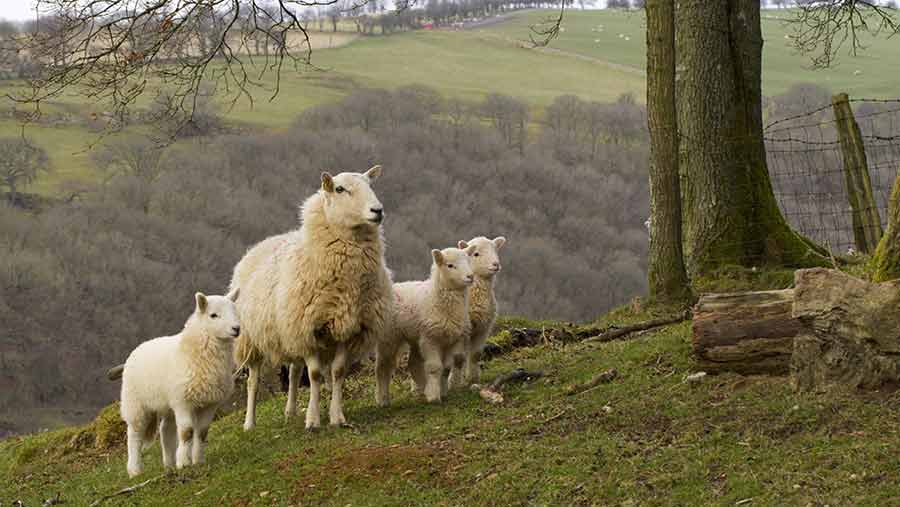Welsh farm income figures show reliance on BPS
 © FLPA / Richard Becker/REX/Shutterstock
© FLPA / Richard Becker/REX/Shutterstock Overall profit is less than the value of the Basic Payment Scheme (BPS) in some Welsh livestock sectors.
New farm income figures for 511 farms surveyed by Aberystwyth University reveal the extent to which BPS underpinned the performance of many Welsh farm businesses in 2015-16.
The true picture is worse still – because the survey uses profit figures before accounting for the value of unpaid labour.
The results are for farms participating in the Farm Business Survey and which have year ends between the end of December 2015 and the end of March 2016.
See also: Farm income figures highlight need for good Brexit deal
After rent and finance charges were deducted, the results showed the average profit for hill cattle and sheep farms was £152/ha, with income from the BPS accounting for £189/ha.
It is a similar situation for hill sheep farms, with the average profit at £167/ha and the BPS income at £165/ha; for lowland cattle and sheep farms the profit/ha was £187 and the subsidy £192/ha.
Survey director Tony O’Regan said farmers were often criticised for crying wolf, but added: “It is difficult to see how many Welsh farms can currently produce food economically without relying on significant non-farming income and timely BPS payments.”
The results highlight significant differences between the average and top-third performing farms. For cattle and sheep farms, the profit a hectare of the top performers was more than double that of the average.
On dairy farms, producers in the top third made a net margin of more than six times that of the bottom third. Meat producers showed similar variability, with lamb producers ranging from making 31p/kg to losing 82p/kg, and beef producers ranging from plus 28p/kg to minus £1.50/kg.
The impact of adding unpaid labour costs to these profit and loss figures is best illustrated by the dairy sector, where labour and pension costs alone can add 7-8p/litre, pushing top producers’ cost of production to more than 26p/litre and the worst-performing producers’ costs closer to 33p/litre, said Mr O’Regan.
Milk price
The figures illustrate how milk contract variations influenced performance.
Businesses in the top third were paid 24.21p/litre, while the bottom third received 21.43p/litre. The average price was 22.49p/litre.
Stocking rate
Dairy farms with the highest stocking rate were more profitable.
For hill and upland dairy farms, the average stocking rate was 2.06 grazing livestock units/adjusted forage hectare but top performers stocked their farms at 2.32.
The pattern was repeated on lowland dairy farms, where the stocking rate on the top third was 2.39 and the average was 2.19.
How the main sectors performed
|
|
All lowland dairy farms |
All hill and upland dairy farms |
All upland cattle and sheep farms |
All lowland cattle and sheep farms |
All hill sheep farms |
All hill cattle and sheep farms |
|
Total income/ha including BPS |
£3,555 |
£3,062 |
£1,028 |
£1,193 |
£742 |
£1,001 |
|
Total variable and fixed costs/ha |
£2,940 |
£1,647 |
£763 |
£930 |
£273 |
£791 |
|
Profit after rent and finance/ha |
£460 |
£270 |
£193 |
£187 |
£167 |
£152 |
|
Unpaid labour/ha |
£87 |
£116 |
£44 |
£57 |
£29 |
£53 |
Source: Aberystwyth University/Farm Business Survey
Top third performers by sector
|
|
Top third lowland dairy farms |
Top third hill and upland dairy farms |
Top third upland cattle and sheep farms |
Top third lowland cattle and sheep farms |
Top third hill sheep farms |
Top third hill cattle and sheep farms |
|
Total income/ha including BPS |
£4,698 |
£3,850 |
£1,291 |
£1,503 |
£924 |
£1,319 |
|
Total variable and fixed costs/ha |
£3,337 |
£2,805 |
£801 |
£1,010 |
£558 |
£870 |
|
Profit after rent and finance/ha |
£1,254 |
£903 |
£423 |
£445 |
£324 |
£392 |
|
Unpaid labour/ha |
£109 |
£125 |
£54 |
£80 |
£40 |
£69 |
Source: Aberystwyth University/Farm Business Survey
